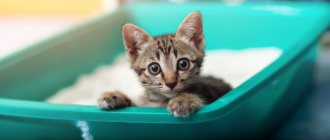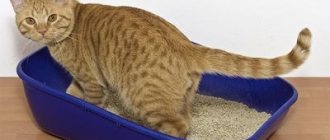What will you learn from the article?
- Why does a cat have bloody urine? Kidney disease
- Inflammation in the ureters
- Urinary system injuries
- Cystitis
- Urolithiasis disease
- Benign and malignant neoplasms in the urinary tract
- Taking medications
- Systemic diseases
- Pathologies of the reproductive system
- Castration operation
- Pregnancy and childbirth
- Errors in diet
- Chemical poisoning
- Catheterization procedure
- Endoparasites
Blood in a cat's urine is a symptom indicating the presence of some disease or pathological condition. Hematuria is the scientific name for this alarming symptom for the cat owner. Visually, hematuria can be noticed by a change in the color of the urine or by bloody spots and blood clots in the tray. It can also be detected accidentally during testing. In any case, it is necessary to immediately contact a veterinarian so that he can determine the cause of this unpleasant symptom.
Common Causes of Hematuria
Blood in the urine (hematuria) is a condition in which cats urinate and produce blood. Its amount varies from a few drops to bulk impurities that change the usual color of urine to light pink or brown.
Note! Hematuria is not an independent disease, but a sign of severe injury (damage) or illness.
Why does a cat pee with blood? Among the main reasons for the appearance of blood in the urine:
- Diseases of the genitourinary system
Most often, the following pathologies are diagnosed in cats: cystitis, urethritis, polycystic kidney disease, etc. Treatment requires immediate contact with a professional veterinarian, who, after examination, will prescribe anti-inflammatory and antibacterial drugs.
- Urolithiasis
Urolithiasis in cats develops as a result of the formation of salt deposits (sand, stones) in the bladder. Owners of British, Persian and Burmese cat breeds need to be especially careful, as they are genetically predisposed to urolithiasis.
- Falling from height
As a result of a strong blow or a fall from a height, the organs of the cat’s genitourinary system can be damaged, which is why blood impurities appear in its urine (most often, copious amounts). Free-ranging animals are especially at risk.
- Drug therapy
Taking incorrectly selected medications in some cases provokes poisoning of the cat’s body, which causes severe internal bleeding. In 95% of cases this is the result of the pet’s self-medication.
- Systemic diseases
If a cat pees with blood, one of the reasons may be infectious processes occurring in the body and affecting internal vital systems (for example, leptospirosis, viral peritonitis).
- Castration/sterilization
After castration and sterilization, animals experience a narrowing of the urinary canals, which leads to the development or exacerbation of urolithiasis. In addition, failure to follow recommendations for nutrition and care of neutered pets after surgery can lead to injury and bleeding.
- Poor nutrition
Cheap dry food, a monotonous low-quality menu, a violation of the acidity level, an excessive concentration of phosphates - all this can provoke poisoning of the pet or diseases of the gastrointestinal tract, the symptom of which is hematuria.
Causes and types of bleeding
A cat's nose may bleed for many reasons. In order to detect them, it is necessary to observe the animal for other symptoms of any disease.
Nosebleeds can be divided into types according to severity:
- Acute – begins suddenly and asymptomatically;
- Chronic – you can systematically notice bloody discharge under the cat’s nose.
Also, bleeding can be bilateral or unilateral. As a rule, they arise for various reasons. To diagnose the disease, it is very important to immediately determine, after the first symptoms of bleeding appear, whether blood is flowing from one nostril or from both. Unilateral bleeding usually indicates the presence of a foreign body, tumor or injury in the nose, while bilateral bleeding usually indicates an infectious disease.
Some cats have an individual tendency to bleed, but such cases are very rare. Most often, this problem is caused by a specific cause that requires urgent medical intervention.
Causes of bleeding:
- Getting injured or bruised as a result of fights and blows that lead to severe swelling;
- Foreign bodies in the animal's nose;
- The presence of cancer and infectious diseases, or diseases of the circulatory system;
- Having problems with teeth;
- Parasites in the nasal cavity;
- Ingress of rat poison into the cat’s body;
- Blood pressure problems;
- Reaction to the use of certain medications;
- The presence of purulent or fungal lesions of the cat’s nasal cavity;
- Consequences of heat stroke.
In some cases, a cat may sneeze and sneeze. Therefore, you need to monitor your pet very carefully so as not to miss this important symptom. You also need to carefully examine the cat's oral cavity: perhaps blood is flowing as a result of damage to the tooth root after a strong collision with a bicycle or car.
What should you pay attention to?
Hematuria is indicated by blood in the urine, which can cause it to change color (for example, red). With severe internal bleeding, the cat develops anemia, during which it loses motor activity, gains weight poorly, and often refuses the food offered.
Often, the release of blood in the urine is accompanied by a deterioration in the general condition of the pet. He tries to lie down most of the time, plays less, and practically does not react to various external stimuli (for example, loud sounds).
Note! In 6 out of 10 cases of hematuria, the cat will experience vomiting and other forms of eating disorder (for example, loss of appetite).
Additional factors to consider:
- bloody urinary incontinence,
- the cat often pees with blood,
- blood impurities are also excreted in the feces.
If you notice that your cat has blood in his urine, pay attention to how he urinates. Usually this process is accompanied by severe painful sensations, so the pet rarely goes to the tray and meows loudly.
What kind of bleeding can there be?
Although the cause of blood loss is always a violation of the integrity of the vessel wall, the bleeding itself can be very different.
Table: classification of bleeding
| Classification sign | Types of bleeding |
| Type of damaged vessel |
|
| Time of bleeding |
|
| Direction of blood flow |
|
With external bleeding, blood flows freely outward
At the same time, no matter how the blood loss occurs (drop by drop, in a thin stream or in a pulsating fountain), external bleeding is almost always clearly visible, while internal bleeding is never visible. And this makes internal bleeding especially dangerous.
What to do if your cat is peeing blood?
If it is not possible to immediately contact a veterinarian if blood is detected in the urine, provide first aid to your pet. When carrying, be as careful as possible, especially if the cat has recently been sterilized or has been injured.
Your actions:
- Provide peace . Don't let your pet go outside. Place him in a warm and quiet place where he feels comfortable and safe;
- Don't give him drugs . Do not self-medicate. Any mistake with the dosage or method of administration will lead to irreversible consequences;
- Nutrition . Eliminate dry and solid food from your cat's diet. Ensure constant availability of fresh water.
Do not hesitate to visit the veterinarian - contact him as soon as possible.
What is the danger of nosebleeds?
In some cases, the presence of bloody discharge from a cat's nostrils requires emergency veterinary attention. As a rule, this is indicated by additional symptoms. Therefore, it is worth examining the animal as soon as bloody discharge from the nose appears.
Signs that accompany a nosebleed and indicate the need to take your cat to a veterinarian:
- When you sneeze, a lot of blood is released;
- There is deformation of the muzzle, swelling on the animal’s body;
- The mucous membrane of the oral cavity acquires a marble color;
- Presence of symptoms of periodontal disease or gumboil;
- The animal's feces become black, acquiring a viscous consistency. This indicates that some of the blood is going inward rather than flowing outward. In such a situation, urgent diagnosis is necessary;
- The presence of an unpleasant odor from the mouth and nose;
- Difficulty breathing;
- The animal sleeps a lot;
- Loss of appetite.
If you have such symptoms, you should contact a specialist for examination and further diagnosis.
Diagnosis of the condition
If your cat is peeing blood, then the first thing to do is contact a veterinary clinic in Moscow. Here, specialists will conduct an initial examination and take urine for laboratory tests.
In order to more fully and accurately diagnose your pet’s condition, the following may be prescribed:
- blood chemistry,
- vaginal smear,
- x-ray of the abdominal organs,
- histological examination,
- cytoscopy.
Having made a diagnosis, the veterinarian prescribes an effective treatment program and determines how to treat your pet.
Obesity in castrated cats
The probability of accumulation of excess weight and obesity in neutered cats is very high. This can even be called a common phenomenon that brings discomfort to the animal. Excess weight accumulates due to a sedentary lifestyle, since castration makes cats sedentary and lethargic, but they continue to eat a lot and with pleasure.
A cat's excess weight is easily visible and noticeable. This is a layer of fat on the abdomen, poor palpation of the spine and ribs. Obesity in an animal can cause various diseases of internal organs, the cardiovascular system, and hormonal imbalance. Obesity also has a bad effect on bones and joints.
It is impossible to start this disease and not reverse its influence. It is better to start treating obesity in the early stages. An important role in the treatment of the disease lies in the physical activity of the cat. Pay more attention to the animal, play with it, give it more opportunity to run and jump, because cats love this very much.
Organize proper and balanced nutrition, take more care of your pet. Add lean meat, vegetables, and dairy products. Use food specially formulated for neutered cats.
Treatment Options
If a cat often pees with blood, then the treatment of this condition will depend directly on the provoking factor. So, if they suffer from urolithiasis, then catheterization of the bladder is prescribed. It ensures the normal outflow of urine through the urethra, while infusion therapy and anti-inflammatory drugs are additionally prescribed.
Other options for eliminating hematuria:
- If blood in the urine is caused by malignant or benign formations , then surgical intervention is prescribed. After tumor removal, it is recommended to follow a number of recommendations from a specialist to prevent re-bleeding;
- Hematuria caused by parasitic diseases is eliminated after an effective course of deworming. Additionally, vitamin and mineral complexes are prescribed to strengthen the pet’s condition;
- When a cat pees with blood after castration (sterilization ), then, depending on the cause, a tight bandage, special massage, drug therapy, and surgical treatment are prescribed.
The treatment program is selected individually. The veterinarian takes into account the cause of hematuria, as well as the general condition of the pet and the characteristics of its body. Timely contact with a specialist is the key to successful treatment for your cat!
How to help a cat with bleeding
When the bandage is applied, the animal should be given sweetened tea or slightly salted water.
The limb on which the wound is located can be raised up. The blood flow to the injured vessel will be weakened.
If there is bleeding on the torso or in the neck area, apply several layers of gauze to the wound. Place a layer of cotton wool on it, then bandage everything tightly.
Also suitable for stopping bleeding are decoctions of oak bark, chamomile, sage, alum solution or iodoform. A gauze swab is soaked in one of these solutions and then applied to the wound before applying a bandage.
Prevention of hematuria
Hematuria is a common problem among cats. It is a symptom of many diseases and often occurs due to injuries (damage). To prevent the appearance of blood in the urine of a neutered cat, provide him complete rest in the first 24 hours after surgery, do not allow him to scratch the wound and make sure that he does not climb even to a small height (sofa, bed, table, etc.).
Other preventative measures include:
- Proper nutrition. This is especially true for castrated and sterilized cats, as well as animals with a predisposition to developing urolithiasis. Consult your veterinarian on how to choose the right medicinal food;
- Vitamin support . A weak immune system is one of the factors that provokes the occurrence of diseases, a sign of which is bleeding. In addition, vitamin A deficiency contributes to the development of urolithiasis;
- Drink plenty of fluids . To prevent salt, sand and other solid particles from gradually accumulating in the genitourinary system, it is important to provide your pet with free access to fresh and clean water. Make sure there is always plenty of it.
Identifying the causes and treating blood in a cat's urine is the responsibility of veterinarians. A timely visit to a specialist will allow you to avoid unwanted consequences and restore the health of your beloved pet!
Preventing common urinary problems in cats
Feline urological syndrome (FUS), as the condition is sometimes called, refers to a spectrum of different conditions that cause urinary problems in furry friends, explains the Cornell Feline Health Center. The reasons for the development of these conditions and methods for their treatment still remain not fully understood. There are two main categories of preventive measures to prevent your cat from developing lower urinary tract disease (FLUTD).
- Environment and stimulation. A cat's life may seem easy and enjoyable, but animals with signs of lower urinary tract disorders may disagree. Cats with urological syndrome are prone to developing stress and require a little more care than most of their cats. Having a choice of places to play, rest, eat and litter will help minimize stress for your cat. For example, each pet should have access to a private sitting area, scratching posts and toys. Cats that are prone to stress often sit on elevated surfaces to monitor their surroundings. Provide a personal litter box for each cat and one additional one. Daily cleaning of the litter box is important for many cats with urological syndrome, as indeed for all other cats. Pets do not like to use a dirty litter tray and, accordingly, can find a cleaner place for their “business” that is less desirable for the owner.
- Proper nutrition and sufficient water in the daily diet. The most important ways to prevent signs of lower urinary tract disorders are to eat a healthy diet and drink enough water. Feeding your cat wet food is the main way to increase her overall fluid intake. Another way to encourage your cat to drink more is to install a fountain with circulating water, place several bowls of water in different places in the house, or perhaps the cat will like to drink water directly from the tap. If your cat drinks enough water, its urine will be less concentrated, which will prevent the formation of crystals, which are the building blocks for uroliths.
It is important to make sure that the cat is eating a complete, balanced food appropriate for its stage of life, and not “all at once.” Some foods contain excess minerals, which can contribute to the formation of crystals and uroliths and, consequently, the development of lower urinary tract diseases.
Although urological syndrome occurs quite often in cats, you should not limit yourself to your own assumptions if a cat walks around with blood. You must immediately seek veterinary help in order to figure out what’s wrong with your pet as quickly as possible and begin the necessary treatment. It is important to remember that acute urinary retention poses a threat to the animal's life and requires emergency medical attention.
How can you notice the appearance of blood in your urine?
Hematuria can most often be determined quite accurately by changes in the color of urine. When red blood cells (RBCs) cause a change in urine color that can be seen with the naked eye, the condition is called overt hematuria. But in those conditions when blood is released into the urine in small quantities, neither the doctor nor the owner will notice a change in the color of the urine, then this condition is called hidden hematuria and it can only be determined by urine analysis. Sometimes cats excrete pure blood, outside the litter box, and remnants of blood can also be seen on the animal’s fur in the perineal area.
Home care
Hemoperitoneum can be an emergency and veterinary attention should be sought as soon as possible. Minimize stress until you can get to the veterinary clinic, keep the animal warm, and ensure peace. If traumatic injury is suspected, be careful when moving your pet as spinal injuries or fractures may be present.
(c) Veterinary center for the treatment and rehabilitation of animals “Zoostatus”. Varshavskoe highway, 125 building 1. tel. 8 (499) 372-27-37
Cystitis in cats
Cystitis is the most common disease in cats after the castration procedure. Absolutely different reasons can provoke cystitis in your pet. This includes poor nutrition, quality of water consumed, stress, hypothermia, weakened immunity, chronic diseases, and various infections.
The basis of treatment for cystitis is proper nutrition - the quality and quantity of food, the regimen of intake. It is necessary to strengthen the animal’s immunity and increase the body’s protective properties.
There are specially designed diets for this; you can learn about them from your veterinarian. The doctor will also prescribe the necessary medication and create a diet.
Prevention of cystitis
Every caring owner of a neutered cat who wants to provide their pet with a long and happy life should know and adhere to the basic rules of feeding their pet:
- do not overfeed the cat, the required feeding schedule is 3 times a day;
- do not treat the animal with food from your table, especially smoked, fried, fatty, soups, pasta...
- dry food should not be given constantly; there are specially designed medicinal foods;
- Only use meat that is not fatty; it is better to steam it. It could be chicken, turkey, beef;
- It’s good to add carbohydrates to your diet – buckwheat, oatmeal;
- Make sure your pet always has access to clean water.
Treatment of cystitis
A specialist should treat cystitis in a cat and prescribe medications. Trying to choose medications on your own can harm your pet and even worsen its condition. The veterinarian will prescribe various medications as necessary.
To eliminate the symptoms of the disease and alleviate the condition, use the drug Stop Cystitis. If the disease is mild, you can take Urotropin. If bacterial microflora is detected, antibiotics may be required. If there is an exacerbation of cystitis, Furacilin will be required.
Only a veterinarian can determine the degree of the disease, the required medications, dosages, and dosage schedule. The task of the owner of a sick animal is to comply with all the necessary instructions of the veterinarian.
Practice disease prevention based on the recommendations in our article. This will help protect your pet from obesity, cystitis and urolithiasis after castration. The health of the animal is always in your hands!











